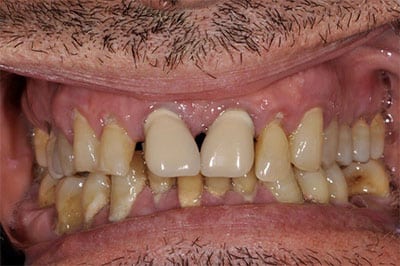Dental implants have been changing lives and restoring smiles since the 1960s and have evolved with time and technology to become one of the most successful and predictable procedures in all of dentistry. Due to the abundance of time, study, and dedication to the perfection of implantology throughout history, more than three million people in the United States today have received a second chance at a beautiful smile.
What Are Dental Implants?
Dental implants are small titanium posts that are placed in the jawbone to serve as artificial tooth roots. Serving as the only restoration that replaces the entire natural tooth structure, this artificial root alone offers numerous benefits beyond any other prosthetic. For starters, the implant post provides a firm foundation for a dental restoration that will not shift or move in the mouth like dentures or bridges. Additionally, because it is placed directly in the jawbone, a dental implant also helps to preserve the natural bone structure by preventing deterioration that typically occurs when a tooth is missing.
In addition to the implant post, there are two other components that complete the implant process: the abutment and the restoration.
- The abutment is a small connector piece that is placed on top of the implant post to serve as a foundation for the restoration.
- The type of dental restoration that is placed on top of the abutment will depend on the number of teeth that are missing. The most common dental restoration used in conjunction with dental implants is a dental crown, which is used to replace a single missing tooth. However, if you are missing multiple teeth, our team may recommend an implant-supported bridge or full-arch prosthetic.


Benefits Of Dental Implants
There are numerous benefits that dental implants can offer, both for patients missing one tooth and those missing multiple teeth. In addition to the benefits that have already been mentioned, dental implants also offer the following:
- Improved oral health: Unlike other tooth replacement options, dental implants do not require alteration of the surrounding teeth. This means that your other teeth will remain healthy and strong, and you’ll be able to brush and floss normally.
- Improved appearance: Dental implants look and feel just like your natural teeth. No one will be able to tell that you have implants, and you’ll be able to smile with confidence.
- Improved function: Dental implants function just like your natural teeth, allowing you to eat all of your favorite foods with ease.
- Improved self-esteem: Losing one or more teeth can be a major blow to your self-confidence. Dental implants can help you feel better about yourself and improve your overall quality of life.
- Improved speech: Dentures and other tooth replacement options can sometimes slip out of place, causing you to mumble or slur your words. Dental implants will not slip or slide, so you can speak with confidence.
- Improved comfort: Dentures and bridges can sometimes be uncomfortable, especially if they don’t fit properly. Dental implants are securely placed in the jawbone, so you won’t have to worry about them shifting or causing irritation.
Types of Implant Solutions
There are a few different types of implant solutions available, depending on your needs and goals. During your consultation, our team will assist you in deciding the best type of dental implant for your smile.
- Single implants: A single implant is placed in the jawbone to support a dental crown. This is the most common type of dental implant, and it can be used to replace a single missing tooth or multiple missing teeth in different areas of the mouth.
- Implant-supported bridge: An implant-supported bridge is used to replace a section of consecutive missing teeth. Similar to a traditional bridge, the appliance bridges the gap; the only difference is that the prosthetic relies on implants rather than natural teeth for support.
- Full-arch implant: A full-arch implant is used to replace an entire arch of teeth, either the upper arch, the lower arch, or both. This type of implant is also sometimes referred to as an All-on-.


